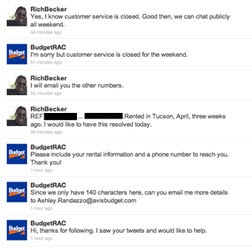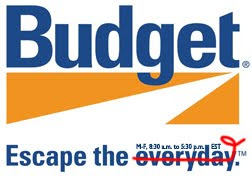 Combined, Budget Rent a Car and its parent company Avis Rent a Car generate about $4 billion in car rental revenues. The company is doing well enough that it has put in a bid to purchase Enterprise or Dollar Thrifty, once it gets past anti-trust hurdles.
Combined, Budget Rent a Car and its parent company Avis Rent a Car generate about $4 billion in car rental revenues. The company is doing well enough that it has put in a bid to purchase Enterprise or Dollar Thrifty, once it gets past anti-trust hurdles.And yet, the company known for its long-running tagline "We Try Harder" and its subsidiary closes customer service on the weekend. Well, maybe. It depends on who you talk to.
Does Avis still try harder? Apparently, not under the Budget banner or on the weekends.
When you receive an unsigned form requesting insurance information from the Budget Vehicle Damage Department as part of an accident "investigation" without any other information — description of damage, evidence, police report — it's something you want to resolve immediately. You feel a sense of urgency, because you know there was no accident or damage.
The form, dated May 6, was received May 14, approximately three weeks from the time of the rental. We know there wasn't a problem because, until May 14, I would have described the rental experience as better than smooth. The attendant who checked the car at the Tucson airport didn't cite any damage. In fact, he adjusted our contract because we brought the car back with a full tank, even though we had prepaid for the gas. Trust me. That never happens.
Any semblance of good will quickly evaporated, not on receipt of the form, but in trying to resolve it. When my wife called the number on the form, she discovered that department was closed. She tried the customer service department, which was also closed.
Then she tried another number, a separate customer service number if you want to extend your rental period. After 20 rings, someone answered. They transferred her to roadside assistance. Roadside assistance was as perplexed as she was about why she was transferred to them.
Since my wife was frustrated, I set my deadline aside to send customer service an email, letting them know I think it sucks that a billion dollar company that provides services on the weekend would shutter up its customer service department during operating hours.
Tip 1. Don't force customers seeking private resolution to look for public customer service.
Believing I would not get a response until Monday, I sought the attention of the person staffing Budget's Twitter account. She immediately offered to help, asking me to follow Budget so we could send direct messages. It's a standard social media tactic that doesn't work unless they can actually help you. This one could not.
The primary goal is to move any complaint away from a public forum not help the customer. Still, the Twitter representative requested various numbers — with each message piling into my DM thread at a rate of four to one. I gave her the information. And within seconds ... she told me customer service was closed on the weekend. Sigh.
Tip 2: Don't castrate your social media reps by limiting their ability to provide customer service.
 I wrote back a cheeky reply and un-followed Budget. With the conversation public again, Twitter monitor Ashley retorted that (sic) "As mentioned, customer service is closed but I would've liked to help w/ the resolution to ur issue when they reopen on Monday."
I wrote back a cheeky reply and un-followed Budget. With the conversation public again, Twitter monitor Ashley retorted that (sic) "As mentioned, customer service is closed but I would've liked to help w/ the resolution to ur issue when they reopen on Monday."My thought about social media is pretty clear on this point. If you empower employees to manage Twitter, they ought to be able to manage customer service. And shortly after that comment, I received an email from Budget's customer service department.
Customer service was suddenly open. He instructed to me to call the Accident and Damage Claims Department (a different department and number than the Investigation Department on the form). They would be open on Monday.
I responded that I thought it was ironic that a customer service department that was supposedly closed would refer me to another department that is supposedly closed. To me, a resolution at this point would no longer be sufficient. An apology was in order.
Tip 3: Don't silo your operations to the point that nobody knows what they are doing.
While I was musing on Twitter that I wondered how many tweets it would take before Budget realized its customer service issue was becoming a crisis communication scenario (about 30 tweets, in case you were wondering), my cell phone rang. It was Budget's customer service department.
The representative told me that they had recently decided to extend their customer service hours. Obviously, somebody forget to tell their social media team.
He asked me to detail the experience, because other than the note his manager gave him to call me, he had no knowledge of my grievance. I started over, being mindful not to allow a rant to overshadow a resolution.
At that point, he assured me that it was Budget's policy to inform the customer of any damage at the point of drop off. He said that although he had no access to claims records, he would advocate my issue on Monday (today) by noon. He gave me his direct number.
 While I wasn't really satisfied, I could accept his course of action.
While I wasn't really satisfied, I could accept his course of action. About a half hour later, customer service emailed me, saying they would gladly provide a formal apology letter and would like to also include a customer service certificate. I told this second representative, who identified himself as an Avis customer service representative on the second email (same person, different company), that if a customer service certificate is a discount, I would still be leery of renting from a company that claims an accident when no accident occurred, three weeks afterward.
I am, of course, very interested in receiving the formal apology. I might even post it in the follow up.
Tip 4: Effective customer service saves your company time, money, and heartache.
Primarily because of the silo-heavy operations and faulty internal communication of Budget, along with Avis (since some operations are apparently shared), five different representatives worked on an issue that they were not able to resolve. Of the five, only one took real ownership (no resolution, but a course of action) and another took partial ownership (no resolution, but the promise of an apology). All of it could have been avoided had the initial customer service department picked up the phone.
But more than that, there were several points of contact that could have taken ownership. None of them ever did. And none of them, despite having the same rental agreement number, knew what the other representatives were doing.
Tip 5: Even minor investigations have a nasty way of uncovering some facts.
Unlike Budget, our small local insurance company and our attorney can be reached to provide customer service on the weekend. What they told my wife was difficult to believe. They both said that with increased frequency, Budget and other car rental companies have started to treat normal wear and tear on vehicles as damages that customers are obligated to pay for.
In fact, had we done as requested — provided insurance information without specific knowledge of any damage or any evidence of damage (keeping in mind there was no damage) — it would have been akin to admitting an incident occurred and that we were liable. They believe, adamantly, that is what Budget was hoping we would do.
They even recommended that we copy and cc the state insurance commission all written correspondence. The problem is that severe. There are state investigations into these fraudulent practices.
Given a car rental company charges rental rates that can pay for a car five times over in a month plus retain the resale value of the asset, it seems almost impossible to believe they would subscribe to such a tactic. However, it's more common than you think.
 Other stories, including those that cite Budget specifically, also say that many companies have reversed their old policy of having agents perform a walkaround with the customer prior to accepting the vehicle. The cursory walkarounds used to be standard practice so customers agreed with the condition of the car before leaving the lot.
Other stories, including those that cite Budget specifically, also say that many companies have reversed their old policy of having agents perform a walkaround with the customer prior to accepting the vehicle. The cursory walkarounds used to be standard practice so customers agreed with the condition of the car before leaving the lot. Rental companies do not staff enough people to do so anymore; some of them even have parent companies man empty service desks part time. Many people have requested a pre-checkout walkaround and have been denied. We certainly didn't get one.
Worse, the general feeling from our insurance representative was that rental car companies specifically target individuals who do not subscribe to the fear marketing that rental companies use to solicit additional insurance and roadside assistance fees. That would include people like my family. We have double coverage when we travel — private insurance and travel insurance from our credit card company — and maintain AAA membership for roadside assistance.
Still, it leaves me to wonder what would happen had we bought additional insurance. Would a claim have been filed without our knowledge, possibly marring a perfect driving record? Maybe so. It's hard to say, especially because if the car was damaged it happened well after we turned it in and and well after we flew home. It's even harder to say because the so-called insurance doesn't insure anything anyway.
Preliminary conclusions about the social media customer service issue with Budget.
To date, I don't even know what the supposed damage to the vehicle is. And based on the perfect return, I don't believe for a minute that we damaged the car — let alone were involved in an accident we can't remember.
Regardless of the resolution and pending apology, I still don't think I would ever rent from Budget again. What I do think is that I will be forever compelled to take pictures of a rental car well before we leave the lot. We can call this disorder they cause Budgtophobia, a severe and overwhelming fear of car rental scum.
Kidding aside, I do advise taking pictures of any rental. From everything I've read on the topic, the only people who successfully see faux claims of damages waived are people who make the issue public or take it to the press. The goal of the company seems to be to look like a hero as they overcome the problems they create and to avoid the rigor of investigative reporters.
All of this is a recipe for mistrust of the company and the rental service industry in general. That's not so easy to do. To earn such a distinction, you really do have to try harder.
Living case study ahead. The follow-up post on Friday, with a growing list of improvement points for Budget Rent a Car.












































